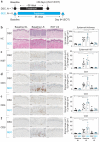Secukinumab and Dead Sea Climatotherapy Impact Resolved Psoriasis Skin Differently Potentially Affecting Disease Memory
- PMID: 38892277
- PMCID: PMC11172747
- DOI: 10.3390/ijms25116086
Secukinumab and Dead Sea Climatotherapy Impact Resolved Psoriasis Skin Differently Potentially Affecting Disease Memory
Abstract
Secukinumab and Dead Sea treatment result in clear skin for many psoriasis patients, through distinct mechanisms. However, recurrence in the same areas after treatments suggests the existence of a molecular scar. We aimed to compare the molecular and genetic differences in psoriasis patients who achieved complete response from secukinumab and Dead Sea climatotherapy treatments. We performed quantitative immunohistochemical and transcriptomic analysis, in addition to digital spatial profiling of skin punch biopsies. Histologically, both treatments resulted in a normalization of the lesional skin to a level resembling nonlesional skin. Interestingly, the transcriptome was not normalized by either treatments. We revealed 479 differentially expressed genes between secukinumab and Dead Sea climatotherapy at the end of treatment, with a psoriasis panel identifying SERPINB4, SERPINB13, IL36G, IL36RN, and AKR1B10 as upregulated in Dead Sea climatotherapy compared with secukinumab. Using digital spatial profiling, pan-RAS was observed to be differentially expressed in the microenvironment surrounding CD103+ cells, and IDO1 was differentially expressed in the dermis when comparing the two treatments. The differences observed between secukinumab and Dead Sea climatotherapy suggest the presence of a molecular scar, which may stem from mechanistically different pathways and potentially contribute to disease recurrence. This may be important for determining treatment response duration and disease memory.
Keywords: T lymphocytes; biologics; inflammatory skin diseases; phototherapy; psoriasis; tissue resident memory T-cells.
Conflict of interest statement
T.E. reports being an investigator on investigator-initiated clinical trials supported by LEO Pharma and Janssen and has received honoraria as a speaker for Bristol Myers Squibb. T.L. is funded by LEO Pharma. L.I. has served as a consultant and/or paid speaker for and/or participated in clinical trials sponsored by the following: AbbVie, Almirall, Amgen, Astra Zeneca, Bristol Myers Squibb, Boehringer Ingelheim, Celgene, Centocor, Eli Lilly, Janssen-Cilag, Kyowa, LEO Pharma, MSD, Novartis, Pfizer, Regranion, Samsung, and UCB. Furthermore, L.I. is an employee at MC2 Therapeutics. C.J. has served as a consultant and/or paid speaker for Eli Lilly, LEO Pharma, AbbVie, and L’Oréal. With no relation to the present manuscript, T.B. has received research funding or educational grants from Novartis, AbbVie, and UCB, and honoraria as consultant and/or speaker from Eli Lilly, Novartis, Leo Pharma, and UCB.
Figures






References
MeSH terms
Substances
LinkOut - more resources
Full Text Sources
Medical
Research Materials

